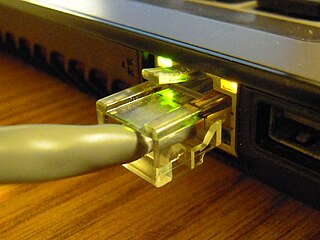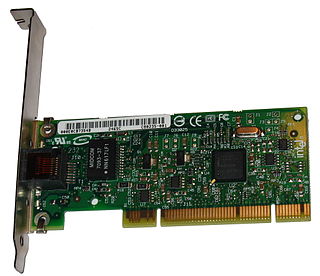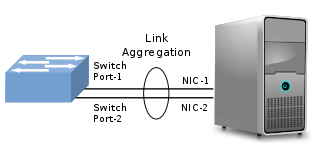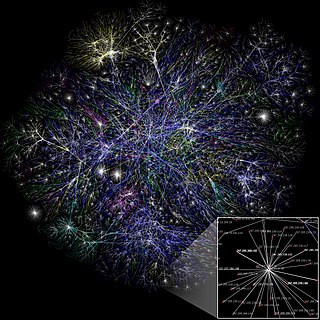Related Research Articles

Ethernet is a family of wired computer networking technologies commonly used in local area networks (LAN), metropolitan area networks (MAN) and wide area networks (WAN). It was commercially introduced in 1980 and first standardized in 1983 as IEEE 802.3. Ethernet has since been refined to support higher bit rates, a greater number of nodes, and longer link distances, but retains much backward compatibility. Over time, Ethernet has largely replaced competing wired LAN technologies such as Token Ring, FDDI and ARCNET.
IEEE 802.3 is a working group and a collection of standards defining the physical layer and data link layer's media access control (MAC) of wired Ethernet. The standards are produced by the working group of Institute of Electrical and Electronics Engineers (IEEE). This is generally a local area network (LAN) technology with some wide area network (WAN) applications. Physical connections are made between nodes and/or infrastructure devices by various types of copper or fiber cable.
A MAC address is a unique identifier assigned to a network interface controller (NIC) for use as a network address in communications within a network segment. This use is common in most IEEE 802 networking technologies, including Ethernet, Wi-Fi, and Bluetooth. Within the Open Systems Interconnection (OSI) network model, MAC addresses are used in the medium access control protocol sublayer of the data link layer. As typically represented, MAC addresses are recognizable as six groups of two hexadecimal digits, separated by hyphens, colons, or without a separator.
A network switch is networking hardware that connects devices on a computer network by using packet switching to receive and forward data to the destination device.
Xerox Network Systems (XNS) is a computer networking protocol suite developed by Xerox within the Xerox Network Systems Architecture. It provided general purpose network communications, internetwork routing and packet delivery, and higher level functions such as a reliable stream, and remote procedure calls. XNS predated and influenced the development of the Open Systems Interconnection (OSI) networking model, and was very influential in local area networking designs during the 1980s.
The Address Resolution Protocol (ARP) is a communication protocol used for discovering the link layer address, such as a MAC address, associated with a given internet layer address, typically an IPv4 address. This mapping is a critical function in the Internet protocol suite. ARP was defined in 1982 by RFC 826, which is Internet Standard STD 37.

In computer networking, Gigabit Ethernet is the term applied to transmitting Ethernet frames at a rate of a gigabit per second. The most popular variant, 1000BASE-T, is defined by the IEEE 802.3ab standard. It came into use in 1999, and has replaced Fast Ethernet in wired local networks due to its considerable speed improvement over Fast Ethernet, as well as its use of cables and equipment that are widely available, economical, and similar to previous standards. The first standard for faster 10 Gigabit Ethernet was approved in 2002.
In the seven-layer OSI model of computer networking, the physical layer or layer 1 is the first and lowest layer: the layer most closely associated with the physical connection between devices. The physical layer provides an electrical, mechanical, and procedural interface to the transmission medium. The shapes and properties of the electrical connectors, the frequencies to transmit on, the line code to use and similar low-level parameters, are specified by the physical layer.
EtherType is a two-octet field in an Ethernet frame. It is used to indicate which protocol is encapsulated in the payload of the frame and is used at the receiving end by the data link layer to determine how the payload is processed. The same field is also used to indicate the size of some Ethernet frames.

The RapidIO architecture is a high-performance packet-switched electrical connection technology. It supports messaging, read/write and cache coherency semantics. Based on industry-standard electrical specifications such as those for Ethernet, RapidIO can be used as a chip-to-chip, board-to-board, and chassis-to-chassis interconnect.

In computer networking, link aggregation is the combining of multiple network connections in parallel by any of several methods. Link aggregation increases total throughput beyond what a single connection could sustain, and provides redundancy where all but one of the physical links may fail without losing connectivity. A link aggregation group (LAG) is the combined collection of physical ports.
The PARC Universal Packet was one of the two earliest internetworking protocol suites; it was created by researchers at Xerox PARC in the mid-1970s. The entire suite provided routing and packet delivery, as well as higher level functions such as a reliable byte stream, along with numerous applications.

Profinet is an industry technical standard for data communication over Industrial Ethernet, designed for collecting data from, and controlling equipment in industrial systems, with a particular strength in delivering data under tight time constraints. The standard is maintained and supported by Profibus and Profinet International, an umbrella organization headquartered in Karlsruhe, Germany.
The Link Layer Discovery Protocol (LLDP) is a vendor-neutral link layer protocol used by network devices for advertising their identity, capabilities, and neighbors on a local area network based on IEEE 802 technology, principally wired Ethernet. The protocol is formally referred to by the IEEE as Station and Media Access Control Connectivity Discovery specified in IEEE 802.1AB with additional support in IEEE 802.3 section 6 clause 79.

A computer network is a set of computers sharing resources located on or provided by network nodes. Computers use common communication protocols over digital interconnections to communicate with each other. These interconnections are made up of telecommunication network technologies based on physically wired, optical, and wireless radio-frequency methods that may be arranged in a variety of network topologies.
40 Gigabit Ethernet (40GbE) and 100 Gigabit Ethernet (100GbE) are groups of computer networking technologies for transmitting Ethernet frames at rates of 40 and 100 gigabits per second (Gbit/s), respectively. These technologies offer significantly higher speeds than 10 Gigabit Ethernet. The technology was first defined by the IEEE 802.3ba-2010 standard and later by the 802.3bg-2011, 802.3bj-2014, 802.3bm-2015, and 802.3cd-2018 standards. The first succeeding Terabit Ethernet specifications were approved in 2017.
The Broadband Forum is a non-profit industry consortium dedicated to developing broadband network specifications. Members include telecommunications networking and service provider companies, broadband device and equipment vendors, consultants and independent testing labs (ITLs). Service provider members are primarily wire-line service providers (non-mobile) telephone companies.
MOST is a high-speed multimedia network technology for the automotive industry. It can be used for applications inside or outside the car. The serial MOST bus uses a daisy-chain topology or ring topology and synchronous serial communication to transport audio, video, voice and data signals via plastic optical fiber (POF) or electrical conductor physical layers.

Audio Video Bridging (AVB) is a common name for a set of technical standards that provide improved synchronization, low latency, and reliability for switched Ethernet networks. AVB embodies the following technologies and standards:
References
- ↑ "Ethernet Configuration Testing Protocol" (PDF). Ethernet Specification. Xerox. 1986-05-08. Archived from the original (PDF) on 2020-12-14.
- ↑ "Ethernet configuration testing protocol (CTP)". 2016-07-21. Retrieved 2016-07-21.